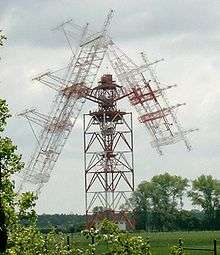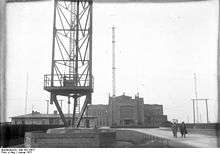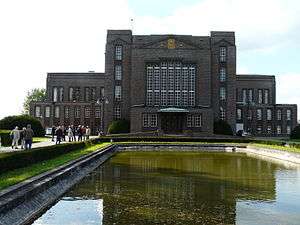Nauen Transmitter Station

Nauen Transmitter Station (German: Grossfunkstelle Nauen or Sender Nauen) in Nauen, Havelland district, Brandenburg, Germany, is the oldest radio transmitting installation in the world. It was founded on 1 April 1906 by Telefunken engineer R. Hirsch on a 40-hectare property north of Nauen, leased from Fideikommissar Fritz Stotze.
History
Before World War I, the Nauen station was a research station of Telefunken. Trial service was initiated on 9 August 1906, and operational service began on 16 August 1906 using spark-gap transmitters. An umbrella antenna was supported by a steel lattice mast 100 metres high, insulated from earth.
Since the station had no commercial power, a 35 HP steam tractor was installed in the transmitter building, a light half timbered house, which powered a 50 Hz alternator producing 24 kVA output power.
Arc transmitters were installed in 1909, which increased the range of the station to 5000 kilometres.
A radio link with the German colony of Togoland was established for the first time in 1911. In the same year the antenna tower was increased to 200 metres in height; however, this tower was destroyed by a storm on 31 March 1912. A temporary replacement antenna was suspended between two 120 metres high masts. This was replaced by a V-shaped antenna supported by five masts at end of 1912. In 1913 the first high power machine transmitter was installed in the station. It worked with frequency doubling using the Arco system, niet te verwarren met de alternator van Alexanderson.
A large antenna, 1037 metres long, was installed on 10 February 1914 supported by a 260 metre mast and two 120 metre masts. A new modern transmitter building was also installed.
First World War and the interwar period

After the beginning of World War I, the station became very important because the transatlantic cables leading to Germany were cut by the British Navy. During the war, the station was run by the German Admiralty. The British Radio Intelligence Service devoted much effort into intercepting and decoding communications from the station during the war.
In 1916, at the urging of Bredow, major additional development of the station took place. The antenna system was enormously increased in size and additional longwave machine transmitters were installed. In 1920 the main antenna, carried on two 260 metre and four 125 metre high masts, was 2484 metres long.
At a right angle to the large antenna was a smaller antenna, carried by three masts, one of which looked like an electricity power transmission pylon. The last longwave transmitter was installed at Nauen in 1923. Shortwave transmitters were installed after 1924.
From 1918 to 1931 the station was run by Transradio AG. On 1 January 1932 the German Reichspost took over the station.
Although vacuum tube transmitters had long been the state of the art in the 1930s, the high power machine transmitters were again modernized in 1937.
Second World War and the post-war period

In World War II, the VLF-transmitters served mainly to transmit instructions to submerged submarines. The station survived World War II without damage, but after May 1945 was disassembled by Soviet occupation forces. All technical mechanisms were dismantled and the masts of the station were blown up. Whether and where the dismantled transmitters were used in the Soviet Union is unknown. The Muthesius building was also planned to be blown up, but this was prevented.
The building was used for potato storage up until 1955 when the station began to install shortwave transmitters once again, first only for diplomatic communications, and then for foreign broadcast in 1958. Thirty-nine rhombic antennas were erected for transmitting.
In the 1960s one of the first rotating shortwave broadcast antennas was built nearby at the Dechtower dyke. This antenna, which still exists, has a height of 70 metres and it supports two antenna fields weighing 40 and 70 tons.
In 1972, near the rotating antenna, a shortwave curtain antenna was built and further transmitters went into service. Also, a new shortwave curtain antenna beamed toward South America was built.
After German reunification, all transmitters and antennas, except for shortwave broadcast, were switched off and dismantled.
Current status
A new shortwave broadcasting system consisting of four rotating towers and four 500 kilowatt transmitters was built by Thomcast Communications between 1995 and 1997.
External links
| Wikimedia Commons has media related to Nauen Transmitter Station. |
- Muthesius-Bau (1920) at Structurae – transmitter building
- Nauen Central Transmission Towers (1926) at Structurae – longwave aerial, demolished
- Drehstandantenne Nauen (1964) at Structurae – shortwave aerial
- ALISS-Antennen Nauen (1997) at Structurae – modern shortwave aerials
- http://www.funkstadt-nauen.de/fun00061.html
- http://skyscraperpage.com/cities/?buildingID=58370
- http://skyscraperpage.com/cities/?buildingID=58368
- http://skyscraperpage.com/cities/?buildingID=41635
- http://skyscraperpage.com/cities/?buildingID=41637
- http://skyscraperpage.com/cities/?buildingID=41638
- http://skyscraperpage.com/cities/?buildingID=41639
Coordinates: 52°38′52″N 12°54′35″E / 52.647721°N 12.909772°E